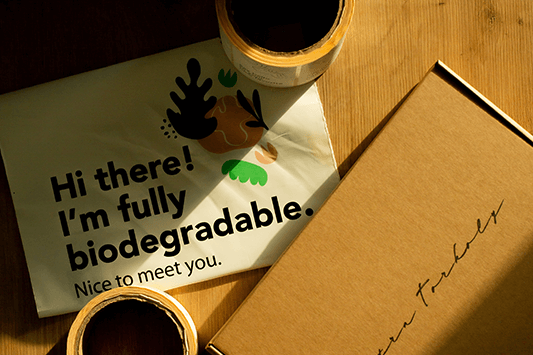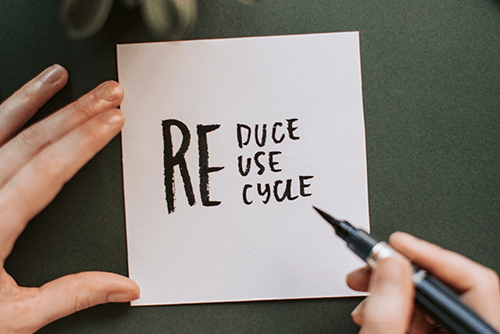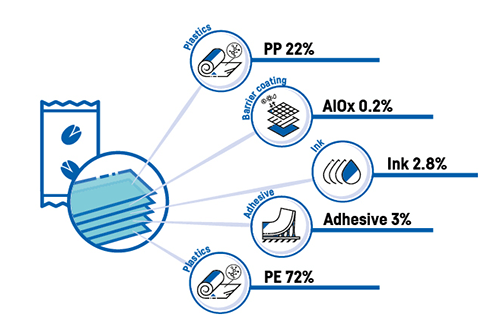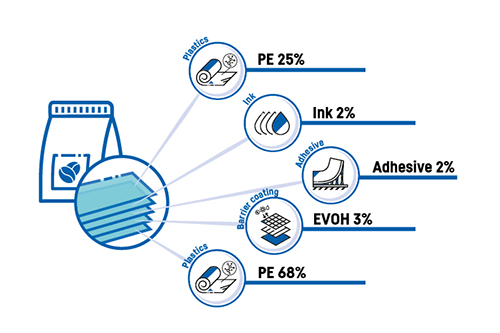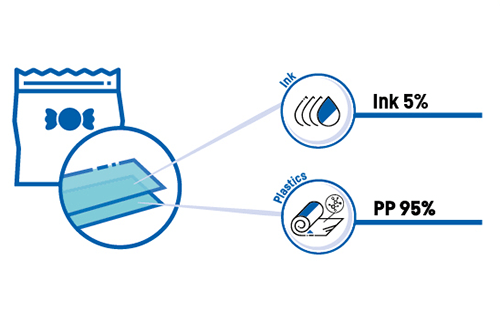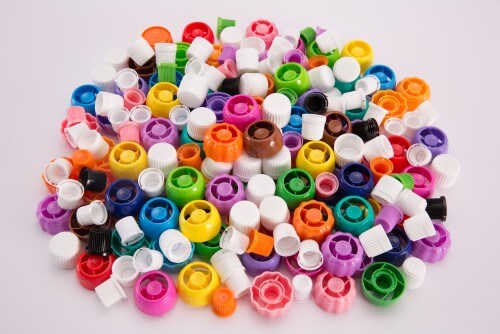Sustainable Packaging
—Future Packaging Trends
What is the Issue we are Facing
Plastic is Ubiquitous
All over the world, plastic debris is everywhere. Humans dump garbage directly or indirectly into the nearest river or lake, and plastic is already filling the world’s oceans. The consequences of plastic pollution go beyond the ecological realm, affecting human health and socioeconomic stability. How to solve the problem of plastic pollution has become a global problem.
Plastic pollution has a significant and wide-ranging impact on the environment, ecosystems, and human health. Include Marine Pollution, Ecosystem Disruption, Soil and Air Contamination, Wildlife Impacts, Human Health Concerns, and Waste Management Challenges.
European Commision Directive
“Preventing packaging waste, boosting reuse and refill, and making all packaging recyclable by 2030.”
How to Cope with Plastic Pollution?
In the current dire state of the environment, it is imperative to address and alleviate environmental issues promptly. As a leading sustainable development packaging company, KDW recognizes its responsibility and obligation to make even the slightest contribution towards environmental preservation. In the realm of flexible packaging, we have devised three viable solutions to effectively reduce environmental pollution and resource waste. That is compostable packaging, bio-based packaging, and recyclable.
Compostable Packaging
Refers to packaging materials that are designed to break down and biodegrade in a composting environment.
Bio-Based Packaging
Refers to packaging materials that are derived from renewable, bio-based sources such as plants, agricultural residues, or algae.
Recyclable Packaging
Refers to packaging materials that can be collected, processed, and used as raw materials to create new products through recycling processes.
Compostable Packaging
Compostable packaging is intended to be composted along with organic waste, such as food scraps and yard trimmings, in industrial composting facilities or home composting systems. In the right conditions, compostable packaging materials can decompose into nutrient-rich compost, which can be used as a natural fertilizer for plants.
Key characteristics of compostable packaging include Biodegradability, Non-toxic, and Environmental Benefits.
Bio-Based Packaging
Bio-based packaging offers several benefits: Renewable and Sustainable, Reduced Carbon Footprint, Biodegradability and Compostability, and Versatility.
Bio-Based Packaging
Bio-based packaging offers several benefits: Renewable and Sustainable, Reduced Carbon Footprint, Biodegradability and Compostability, and Versatility.
Recyclable Packaging
Recyclable packaging refers to packaging materials that can be collected, processed, and used as raw materials to create new products through recycling processes. These materials are designed to be easily sorted and separated from other waste, allowing them to be efficiently recycled and reused.
Common examples of recyclable packaging materials include Cardboard and Paper, Glass, Aluminum, Steel, PET, and HDPE Plastic.
Sthrenghs & Weeknesses for
Sustainable Packaging Solutions
These three sustainable packaging, Compostable packaging, Bio-Based packaging, and Recyclable packaging with different strengths and weaknesses ( refer to the form below ). They all benefit to environment and market demand. The raw materials for compostable packaging and bio-based packaging are from renewable biomass sources, most of then are food sources as well. The shortage of food all over the world is still very serious. Africa South of the Sahara and South Asia are the regions with the highest hunger levels and are most vulnerable to future shocks and crises. Global progress against hunger has largely stagnated in recent years, according to the 2022 GHI. In many countries across regions, the situation has worsened. Indeed, one indicator used in the GHI, the prevalence of undernourishment, shows that the share of people who lack regular access to sufficient calories is increasing, with as many as 828 million people undernourished in 2021. Without a major shift, neither the world as a whole nor approximately 46 countries are projected to achieve even lower hunger as measured by the GHI by 2030 ( Refers to the 2022 Global Hunger Index ). By contrast, recyclable packaging is more reasonable at this stage for sustainability.
Consumer Appeal,
Biodegradability and Compostability
Performance Limitations,
Shortage of raw materials
Market Demand,
Resource Efficiency
Cost Considerations,
Shortage of raw materials
Market Demand,
Infrastructure and Accessibility
Design Complexity
How to Design a Recyclable Packaging?
How to design a recyclable packaging? The CEFLEX initiative, designing for a Circular Economy (D4ACE) Guidelines, will facilitate the development of a circular economy for flexible packaging by 2025. Only with near-universal adoption of these and related guidelines will this ambition be realized.
Recycling has a central role to play in enabling flexible packaging to contribute effectively to a circular economy and after waste prevention, this is where most progress is expected to be made in the short to medium term.
A 5-step roadmap to build a circular economy for flexible packaging has been endorsed by CEFLEX stakeholders, together with a set of actions needed by each part of the value chain to make it happen.
- DRIVE COLLECTION of ALL flexible packaging for sorting and recycling
- SORT and RECYCLE the suitable mono-material fractions
- REDESIGN multi-material flexible packaging to mono-materials with existing recycling streams where possible
- IDENTIFY SOLUTIONS and develop capabilities to sort and recycle the remaining fractions
- END MARKETS for all recycled flexible packaging materials
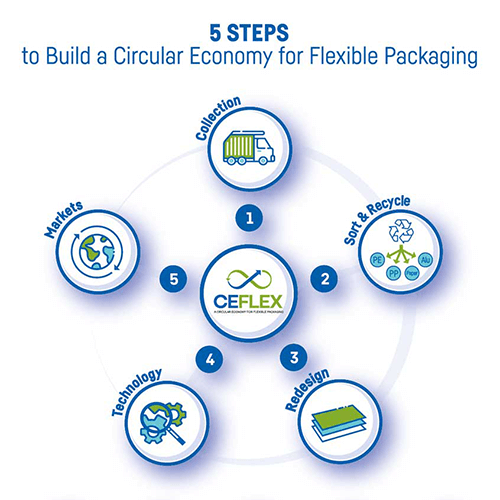
Flexible Packaging Design Requirements
Core Design Requirements
Product Protection
Usage
Information
Marketing
End of Life Design Requirements
Collection
Sortability
Recyclability
Design for a Circular Economy
Preference for Plastic Recycling Streams from
Post-consumer Polyolefin-based Flexible Packaging
PE
PP
Flexible mono-PE
Stream already exsits in some European countries with some market applications established.
In future this stream may develp futher to include sub-streams for esample recyled PE film natural, recycled PE film coloured.
Flexible mono-PP
Stream is either being developed or under consideration in Europe.
Expectation that a range of viable non-food contact market applications, including film, will be developed.
Flexible mixed PO
Plastics
Mixed plastic including flexibles
Elements of a Flexible Packaging Structure
- Materials: Plastics, Paper, Aluminum, Varrier coatings & layers
- Size & shape
- Density
- Adhesives
- Pigments
- Additives & fillers
- Printing, inks and lacquers
- Labels
- Additional features
Examples of Flexible Packaging Structures
CEFLEX’s design for a Circular Economy Guidelines gives practical support and advice on circular economy design principles. The comprehensive guidelines have been developed to help anyone working in the flexible packaging value chain design packaging solutions which are recyclable.
We Have Rich Experience for
Sustainable Packaging Solutions
Recyclable Packaging Proposals
Sustainability Actions at KDW
Raw Materials / Suppliers
Manufacturer Production
Distribution
Use by Retailer
Consumer Use
End of Life (Recycling, Disposal)
Solar Panels Automatic Power Generation Systerms
- 6,640pcs Solar Panels were installed on the roof of KDW factory in 2022, which will produce 3.05MWp power capacity. The solar panels automatic power generation systems provide around 15~20% of the whole KDW power consumption. help KDW reduce energy costs by generating electricity from a renewable source.
- The solar panels connect the state grid directly and reduce reliance on the grid and mitigate the risks associated with fluctuating energy prices or potential power outages. We can maintain a stable and reliable energy supply, ensuring uninterrupted production processes.
- By adopting solar panels, KDW demonstrates our commitment to environmental sustainability and reducing the carbon footprint. Solar energy is a clean and renewable energy source that produces no greenhouse gas emissions during operation. Implementing solar panels aligns with corporate social responsibility goals.
Focus on Economic, Social Responsibility,
Environment contribution
- Reduce primary and secondary energy use via plant-specific energy efficiency programs.
i.e. compressed air, lighting, heating, ventilation and air conditioning and cooling systems - Improve the efficiency of drying/heating processes.
i.e. improve drying air recirculation (printing, lacquering, etc.). - Reduce process waste and rework.
- Reduce solvent consumption and related emissions (VOCs)
- Solvent recovery
- Solvent less processes
- Reduction of solvent uses and solvent losses
- Mono Material- Recyclable Packaging
- PE base film
- PP base film
At KDW, we are proud to announce that we have implemented VOCs within our plant, enabling us to recycle over 3000 tons of solvent per year. This commendable achievement not only showcases our commitment to sustainability but also marks a significant step towards a more environmentally responsible future.
MONO Materials for Sustainable Packaging
Mono material packaging helps facilitate the recycling process and contributes to creating a more circular and sustainable economy.
Through unremitting effort by KDW’s R&D, we have our own recycleable brand KanRe™, which made an outstanding contribution to our recycling business.
Mono-material plastic at KDW, such as HBE, HLE, GBP, GLP, HBP, HBO, consists of our mono material flexible packaging, suitable for a variety of applications, such as food packaging, non-food packaging, and industrial packaging.
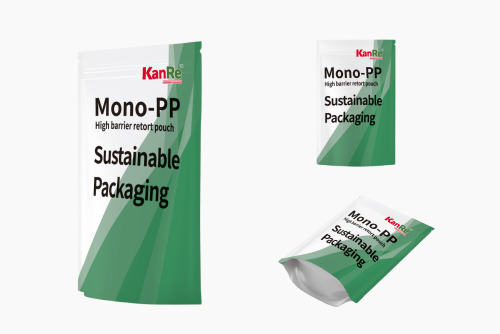
How to Design the Packaging for Different FMCG Segments
The CEFLEX initiative, Designing for a Circular Economy (D4ACE) Guidelines, will facilitate the development of a circular economy for flexible packaging by 2025. Only with near-universal adoption of these and related guidelines will this ambition be realized.”Quoted from CE-FLEX.
Post-Consumer Recycled Material
Post-consumer recycled (PCR) material is the materials that have been recovered or recycled from products that have reached the end of their useful life as consumer items to reduce the demand for virgin materials and minimize waste. These materials are obtained from various sources, such as discarded packaging, used products, or materials collected through recycling programs.
PCR materials can include a wide range of materials, such as plastics, paper, cardboard, glass, metals, and textiles. These materials are typically broken down, melted, or reprocessed to create new raw materials or components that can be used in the manufacturing of different products. A variety of recycled materials, including PET, PE, PP, HDPE, and more. These materials are derived from post-consumer waste plastics, such as lunch boxes, shampoo bottles, mineral water bottles, washing machine buckets, and other plastic products that have served their initial purpose.
The use of post-consumer recycled materials offers several environmental benefits:
- Resource conservation: By recycling and reusing materials from discarded products, the demand for virgin materials is reduced, leading to the conservation of natural resources such as timber, minerals, and petroleum.
- Energy savings: Manufacturing products from recycled materials generally requires less energy compared to producing products from raw materials. This helps to reduce greenhouse gas emissions and lower the carbon footprint associated with the manufacturing process.
- Waste reduction: Utilizing post-consumer recycled materials diverts waste from landfills, helping to reduce the volume of waste and alleviate the strain on waste management systems.
- Environmental impact reduction: The recycling of post-consumer materials can help reduce pollution and environmental damage associated with extracting and processing raw materials, as well as the disposal of waste in landfills.
Post-consumer recycled materials are materials obtained from products that have reached the end of their life cycle as consumer items. By incorporating PCR materials into the manufacturing process, companies can contribute to resource conservation, energy savings, waste reduction, and a lower environmental impact.
At KDW, we have taken significant strides in the realm of post-consumer recycled materials, aligning with our unwavering commitment to sustainability. We recognize the importance of reducing our environmental impact and actively contribute to the circular economy through our initiatives.
- PET film: 70% PCR materials
- PE resin: 40% PCR materials
- Plastic spout caps
Post-Industrial Recycled Material
Post-industrial recycled material refers to materials that are recycled from manufacturing or industrial processes rather than consumer waste. These materials are typically generated during production, such as excess or scrap materials, offcuts, trimmings, or defective products that do not meet quality standards.
Post-industrial recycling involves collecting, sorting, and processing these waste materials within the manufacturing facility or through specialized recycling facilities. The materials are then reprocessed and transformed into new raw materials or components that can be used in the production of various products.
PCR & PIR Materials
Both PCR (Post-Consumer Recycled) and PIR (Post-Industrial Recycled) plastics offer distinct advantages, depending on the context and specific requirements. It’s important to note that both PCR and PIR plastics fall under the broader category of recycled plastics within the rubber and plastic industry.
PCR plastics have a significant advantage in terms of quantity. Since they are derived from post-consumer waste, such as discarded packaging, bottles, and other consumer products, there is a substantial volume of these materials available for recycling. PCR plastics contribute to waste reduction by diverting materials from landfills and reprocessing them into new raw materials.
On the other hand, PIR plastics have an absolute advantage in terms of reprocessing quality. As they are derived from post-industrial waste generated within manufacturing processes, PIR plastics tend to have a higher level of control and consistency in terms of material quality. Since the waste comes from controlled production environments, it is often less contaminated and easier to reprocess into high-quality recycled materials.
Each type of recycled plastic has its unique advantages and applications. PCR plastics are well-suited for applications where a high volume of recycled material is required, such as packaging or consumer goods. PIR plastics, with their higher reprocessing quality, are often preferred for applications that demand stricter material specifications, such as automotive parts or specialized industrial products.
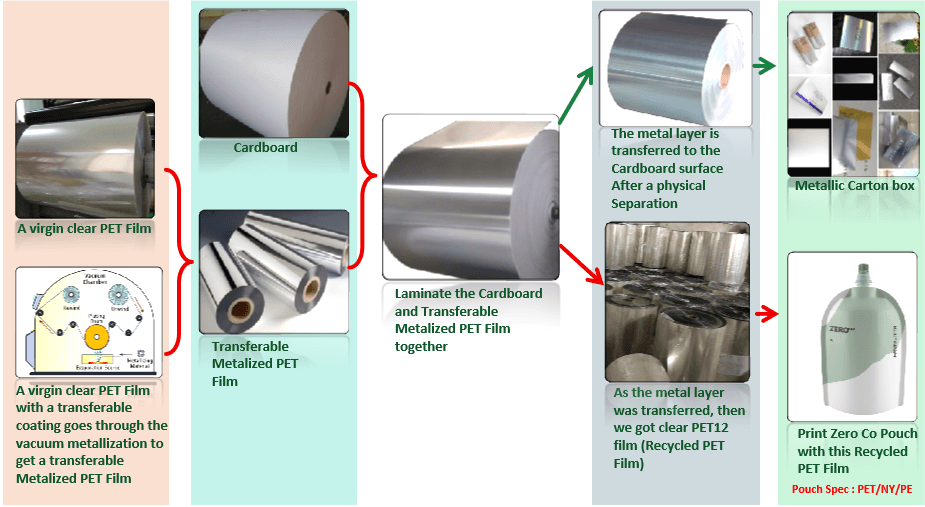
PCR PET Film
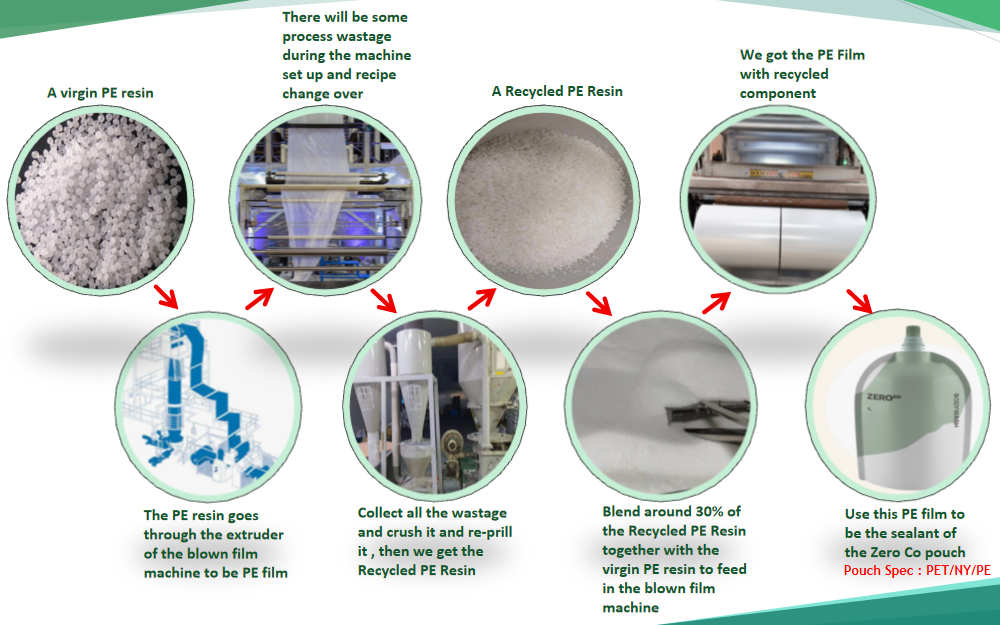
PIR Film
Global Recycled Strandard Certificates
The Global Recycled Standard (GRS) is an international, voluntary certification program that sets requirements for the content and traceability of recycled materials used in products. It provides third-party verification of recycled content claims and ensures that certain environmental and social criteria are met throughout the supply chain.
Kinderway Packaging proudly holds the Global Recycled Standard (GRS) certificate as of November 2023. This certification serves as a testament to our unwavering commitment to social responsibility and sustainable packaging practices.
By adhering to the GRS guidelines, we ensure that our packaging materials contain verified recycled content and meet stringent environmental and social criteria. This achievement reinforces our dedication to promoting a circular economy and reducing our ecological footprint.
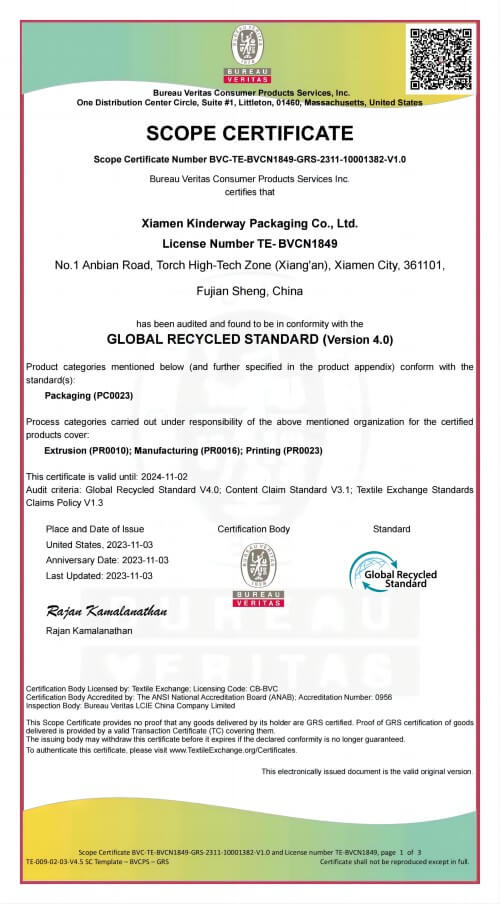
Start With KDW
+86 13559233681(Wechat, Whatsapp)
No1, Anbian Rd, Torch High-Tech Zone (XiangAn), Xiamen, Fujian, China





